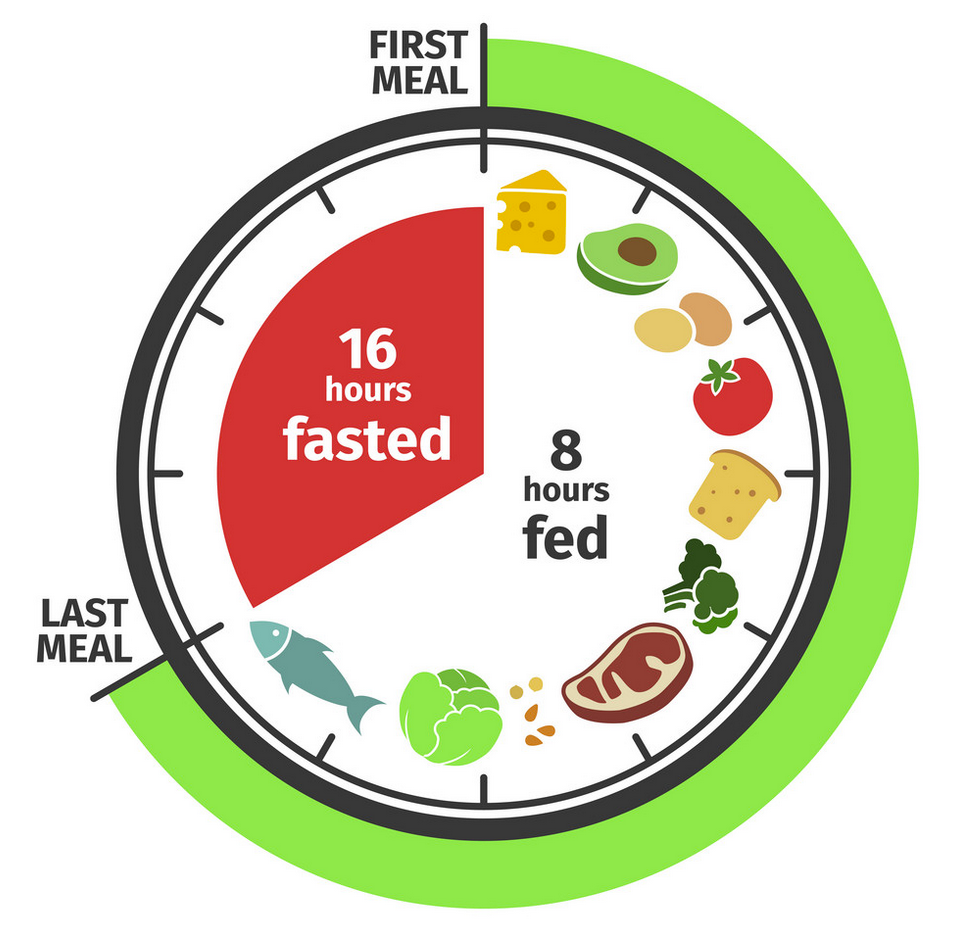Overview
Fasting has already been a practice for millennia.
Sometimes, people fast out of necessity, especially when they have nothing to eat. And some religions, including Islam, Buddhism, Judaism, and Christianity, mandate some form of fasting. Additionally, humans and other animals usually fast instinctively when sick.
One of today’s most popular health and fitness trends in the world is intermittent fasting, which involves alternating cycles of eating and fasting.
What Is Intermittent Fasting?

Intermittent fasting is not a diet, but rather described as an eating pattern that does not specify which food to eat but rather when you should eat them.
This eating pattern has numerous potential benefits: it protects you against certain diseases, improves metabolic health, enhances cardiovascular and brain functions, causes weight and fat loss, simplifies your lifestyle, and promotes longevity.
Fasting is natural. It is, in fact, more natural to fast from time to time than eating 3+ meals every day.
When we fast, all sorts of processes in the body change to enable our bodies to thrive during periods of famine. The body adjusts the hormone levels so that the stored body fat becomes more accessible, and the cells also initiate important repair processes and change gene expression.
Thus, our bodies are well equipped to suppress hunger and handle extended periods of famine.
Intermittent Fasting Methods
If you’re planning to start intermittent fasting, there are different methods for you to choose from and experiment to see what’s best for you. Each method will produce significantly different results. The following are 3 most popular methods of intermittent fasting.
Leangains Daily Intermittent Fasting (Popularized By Martin Berkhan of Leangains.com)
Leangains daily intermittent fasting involves a 16-hour fast followed by an eating window of 8 hours. This method is done every day, so it becomes very easy to adjust into and adapt the eating habit on this schedule. This is probably the best method to achieve and maintain a lean physique.
Here’s how to do it.
1. Conduct a daily 16-hour fast (about 8 hours of the fast takes place while you are sleeping).
2. After the 16-hour fast, you can eat your first meal of the day.
3. Start another 16-hour fast 8 hours after your first meal.
4. You can do what works best for you as it does not matter when you start the 8-hour eating window. But just so you know, it is also suggested to choose a feeding period that lets you finish your meals early, like 9:00 a.m. to 5:00 p.m., because your body becomes less efficient at putting sugar away as the day goes by. Refer to the figure below.
Weekly Intermittent Fasting
Weekly intermittent fasting involves a weekly 24-hour fast. This is a great option if you’re looking to keep your weight on or bulk up.
You can enjoy the numerous fasting physiological benefits without losing weight since you are only cutting out two meals per week.
Here’s how to do it.
1. Conduct a 24-hour fast once a week (about 8 hours of the fast takes place while you are sleeping).
2. If you eat your lunch on Monday (day 1), you then fast until lunch on the following day (Tuesday). Refer to the figure below.
Alternate-Day Intermittent Fasting
Alternate-day intermittent fasting involves fasting for alternating 24-hour periods. This method is usually used in many studies.
Here’s how to do it.
1. Start a 24-hour fast every other evening (about 8 hours of the fast takes place while you are sleeping).
2. You can finish your dinner and begin a 24-hour fast on Monday at 7 pm.
3. Then every other evening, break the fast and start a 24-hour feeding period. For example, you could start fasting on Monday at 7 pm and eat your next meal at 7 pm the following day (Tuesday).
Breaking the Fast
After a stretch of not eating, you are now ready to break your fast. Be sure not to overeat as you break the fast and start by eating gentle foods. Introduce only small portions of foods that can be easily digested so you don’t overwhelm your digestive system. Otherwise, you might experience bloating and discomfort.
Avoid foods that are high in fat, sugar, or even fiber (such as a slice of cake, greasy cheeseburger, or soda and seeds, nuts, or other high-fiber raw produce) as they can be even more shocking to your system and difficult for your body to digest.
Break your fast by eating gentle but nutrient-dense foods that can be digested easily and contain a bit of some healthy fats (e.g., avocados and eggs) and a bit of protein, such as soups, smoothies, fermented foods, vegetables.
Breaking your fast by eating nutritious foods that are gentle to the digestive system helps replenish essential electrolytes and nutrients while easing food back into your diet. Once your system has tolerated gentle foods, you can slowly add in other healthy foods such as beans, whole grains, seeds, meat, nuts, vegetables, fish, and poultry to return to your normal eating.
Intermittent Fasting for Weight Loss
The most common reason many people do intermittent fasting is to achieve weight and fat loss.
A study by Johnstone (2014) concluded that fasting is a relative “quick fix” in achieving a substantial weight loss in just a few weeks, and therefore may be a useful tool for weight loss.
Gotthardt and Bello (2017) also found in their animal study that alternate-day fasting reduced body weight in mice in just 4 weeks, and concluded that the method used can be an effective weight loss strategy.
Fasting helps you eat fewer calories, resulting in weight loss.
How Does Intermittent Fasting Work For Weight and Fat Loss?
To fully understand how intermittent fasting leads to weight and fat loss, it is essential to understand the difference between the fasted state and the fed state first.
Fed State
Your body is in the fed state when it is in the process of digesting and absorbing foods. This state begins as you start eating, which usually takes 3–5 hours for your body to digest and absorb the food you ate.
During this state, your insulin levels are high, which makes it hard for your body to burn fat.
Post Absorptive State
After the fed state, your body goes into the post absorptive state, wherein it is not processing a meal.
Fasted State
The post absorptive state takes 8–12 hours after your last meal—and that is when you enter the fasted state.
During fasted state, your insulin levels are low, which makes it much easier for your body to burn fat.
Fasting not only puts your body in a fat-burning state, but also allows you to lose fat without having to change what you eat, how much you eat, or how often you exercise.
However, it’s really rare for your body to be in the fat-burning state since we can’t say we are in the fasted state until 12 hours after the last meal.
Intermittent Fasting Benefits
1. Intermittent fasting simplifies your day.
With fasting comes a reduced number of meals you have to plan, prepare, and eat. This gives you an opportunity to be productive during the day. Planning, preparing, and eating meals should not be the focus of your everyday life.
2. Intermittent fasting promotes longevity.
Intermittent fasting, on the other hand, involves calorie restriction, and scientists have known for a long time that calorie restriction leads to longevity.
In fact, an animal study by Fontana (2009) found that long-term calorie restriction without malnutrition leads to some of the same hormonal and metabolic adaptations related to longevity in calorie-restricted rodents.
Another animal study by Mattson and Wan (2004) found that calorie restriction and intermittent fasting increase resistance to age-related diseases and extend lifespan in rodents and monkeys, as well as improve the health of overweight humans.
However, further human studies are needed to elucidate the potential benefits of calorie restriction in humans.
3. Intermittent fasting has the potential to reduce the risk of cancer.
A 2010 study found that calorie restriction in a mouse model has anti-cancer properties.
Unfortunately, this study has limitations. Further human studies are necessary to clarify the effects of calorie restriction on humans with cancer.
4. Fasting helps you get lean.
As mentioned earlier, fasting puts your body in a fat-burning state, which could hardly be achieved when following a normal eating schedule.

5. Intermittent fasting is a lot easier compared with traditional diets.
Intermittent fasting is an effective weight loss strategy that is remarkably easy to stick to even in the long term, unlike the traditional diets which are difficult to follow over a long period of time.
Should I Do Intermittent Fasting?
Intermittent fasting has several potential health benefits to offer. One of the most common reasons people fast is to lose weight and fat. And if your goal is the same, then the answer is yes.
The best way to determine which method works for you is by experimenting it.
However, although intermittent fasting can be beneficial to some people, this is not for everyone. People who are underweight, have underlying health conditions, pregnant women, lactating women, and children are not advised to do intermittent fasting. It is not a good idea because it might lead to some health complications.
It is therefore essential to seek your doctor’s advice for this matter.
Conclusion
Intermittent fasting has a lot of potential health benefits: it protects you against certain diseases, improves metabolic health, enhances cardiovascular and brain functions, causes weight and fat loss, simplifies your lifestyle, and promotes longevity.
There are different ways of doing intermittent fasting: you can either do it daily, weekly, or alternately. Each method has different end results. That’s why it is also important to experiment which works best for you.
However, it is also noteworthy that intermittent fasting is not for everyone, especially those who are underweight, have underlying health conditions, pregnant women, lactating women, and children. It can be harmful for them.

READY TO GIVE INTERMITTENT FASTING A TRY? WAIT!
You are not being told about many of the most important fasting breakthroughs being discovered by leading doctors and medical research centers.
There’s no big conspiracy.
It’s just that these breakthroughs usually don’t get much publicity.
That’s because they’re reported in medical journals intended for doctors such as The New England Journal of Medicine… The Journal of the American Medical Association… Lancet… The American Heart Journal… among many others.
Or, in some cases, these discoveries are made in prestigious health centers in other parts of the world, and receive little or no coverage in the US media.
In still other cases, highly respected medical doctors uncover these breakthroughs in clinical studies in their own private practices. They report their findings to professional medical societies, but these discoveries often escape the notice of the mass media.
All of this leaves gaping holes in the health information you should be getting. Yet these “under-reported” discoveries can be of tremendous importance to you and those you love.
That’s why we created My Health G.O.A.T. (Greatest Of All Time).Until My Health G.O.A.T. came along, if you wanted to try to keep on top of new intermittent fasting developments and scientific breakthroughs, you would have to subscribe to a shopping cart full of professional medical journals and newsletters.
And you’d have to spend a king’s ransom for the privilege!
You might also have to get a medical degree to understand many of the articles. But now that’s changed, thanks to My Health G.O.A.T.
Here are our top 11 articles you can read right now that will help give you a shortcut to success during your health and wellness journey as you learn more about intermittent fasting:












